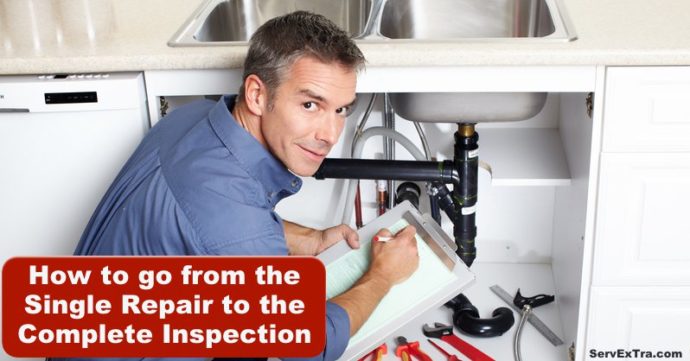Blog
3 Steps from the Single Repair to the Complete Inspection
By Todd Liles • 3 Steps from the Single Repair to the Complete Inspection
The most valuable process to a technician is the complete inspection. It assures that the most accurate diagnostic, and accurate recommendations, are given to the homeowner. This leads to a boost in average tickets, and a reduction in callbacks. Yet, most techs will leave a home with only the immediate problem being addressed.
As a sales and service trainer, I make it our responsibility to ensure our Plumbers, Electricians, and HVAC Techs have the communication tools they need to get a complete inspection on every call. You can use this same process to get a complete inspection on your next call!
#1 – Communicate the 3 Causes of Failure
The best approach to getting a complete inspection is to educate the homeowner on why systems fail. Most plumbers, hvac techs, and electricians that we train find it best to do this before they complete the diagnostic. It occurs on the first diagnostic. Think of the first diagnostic as the questions you ask the client, and the second diagnostic as actually reviewing the failed component.
I will use the following scripting example to create clarity. Even though I’m using a plumbing example, you will be able to easily apply this approach to air conditioning or electrical service:
“Mrs Smith, in a moment I’m going to disassemble this faucet. I will do a visual check on the internal components to determine what is causing the leak. I can check 2 causes of failure here, but not the 3rd. Are you familiar with the 3 causes of failure?”
- Quality: “The first cause of failure is quality. Some plumbing products use higher quality materials that last longer, and some do not. I will open this faucet to see if it is using plastic interior components, or if it is using high quality metal and ceramic components.”
- Use: “The second cause of failure is design and use. Faucets are going to wear out faster in areas where they get more use. Use should be taken into consideration when choosing a new faucet. With that in mind, can I ask you some questions about how much this faucet is used?”
- Supply Conditions: “The last cause of failure is supply conditions. When you think of supply, think of the incoming water condition and pressure. I will need to check to see if the water pressure is within the faucet’s design range. If it exceeds the pressure range, then that will create a situation that will not only damage your faucet, but every other component in the house.”
#2 – Check the Connected Systems
In the example above, I presented the need to check the incoming water pressure. This step makes logical and tactical sense for all. It is the best way to assure that a plumber is offering the best recommendations.
This same approach can be applied for the other trades as well. For the electrician, he can easily transition to the panel from the outlet. The HVAC Tech can just as easily transition from the condenser to the furnace.
#3 – Offer a Complete Inspection
Once you have offered to check one connected component, getting a complete inspection is a natural and easy step.
“Mrs Smith, we have confirmed that your water pressure is high. I wonder how it has effected your other faucets, water heater, and toilets. When was the last time you had them inspected for wear and tear? Wow! That’s a long time. I’m happy to look at them for you while I’m here, would you like me to do that for you?”
Offering complete system inspections is the height of professional service. Many techs get hung up on the idea that inspections make them look like a salesman. I call BS on that thought process! Not doing inspections makes you look like a hack. RELATED: The Life Saving Benefit of Inspections
Question: How do you offer the inspection to your client? Please comment and share on Facebook and LinkedIn.
What SETs Us Apart?
Proactive Business Plans
A proactive business is a successful business. That's why our team takes the time to make sure every client has a proactive, not reactive, business plan. Our strategies make your business run more smoothly and profitable.
Proven Results
Our training services help businesses identify and achieve their key performance indicators (KPIs). Whether it's increased revenue or higher satisfaction rates, our methods allow you to see immediate and continued results.
Personalized Training
Our team of experts works hard to make sure your business gets personalized training. We'll work with your team one-on-one or in group settings to set and achieve your business goals. We develop training based on your goals!
Prioritizing People
We believe that people are the most valuable asset. We strive to provide outstanding benefits, life balance, leadership, and support to our team. We believe in helping people reach their greatest level of growth, contribution and satisfaction.

Trusted By
Business Ignition
SPARK
Classroom Training
Resources
Company

Join our newsletter











